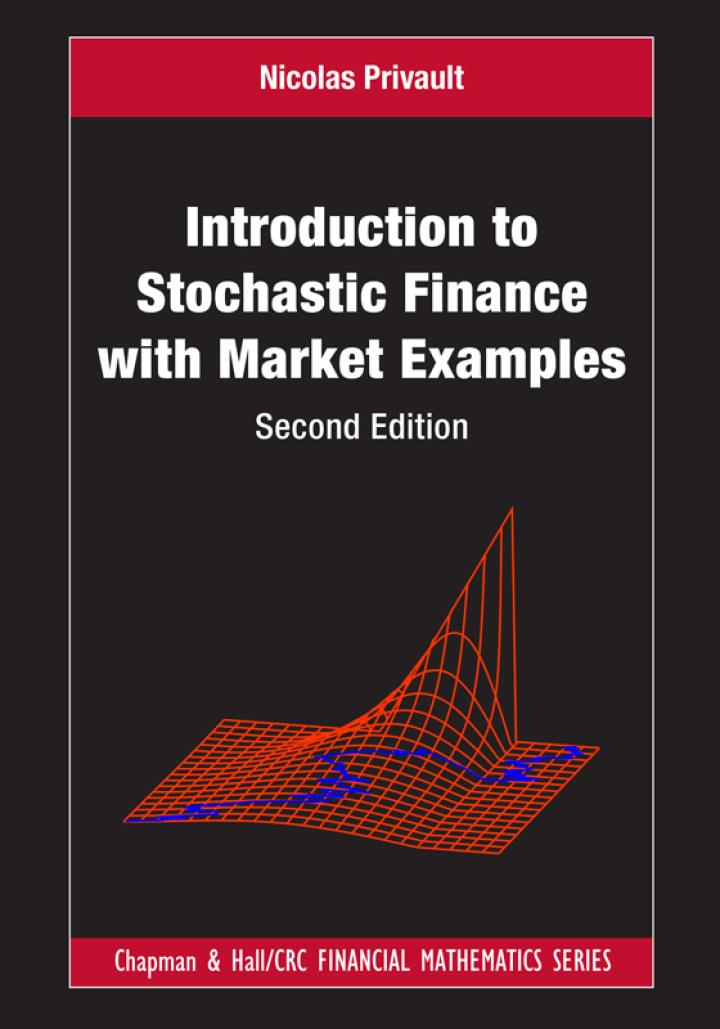Consider a price process (left(S_{t}ight)_{t in mathbb{R}_{+}})given by [ frac{d S_{t}}{S_{t}}=r d t+sigma d B_{t}, quad S_{0}=1
Question:
Consider a price process \(\left(S_{t}ight)_{t \in \mathbb{R}_{+}}\)given by
\[
\frac{d S_{t}}{S_{t}}=r d t+\sigma d B_{t}, \quad S_{0}=1
\]
under the risk-neutral probability measure \(\mathbb{P}^{*}\). A binary (or digital) call, resp . put, option is a contract with maturity \(T\), strike price \(K\), and payoff
\[
C_{d}:=\left\{\begin{array}{ll}
\$ 1 & \text { if } S_{T} \geqslant K, \\
0 & \text { if } S_{T}
\$ 1 & \text { if } S_{T} \leqslant K \\
0 & \text { if } S_{T}>K .
\end{array}ight.ight.
\]
Recall that the prices \(\pi_{t}\left(C_{d}ight)\) and \(\pi_{t}\left(P_{d}ight)\) at time \(t\) of the binary call and put options are given by the discounted expected payoffs
\[
\begin{equation*}
\pi_{t}\left(C_{d}ight)=\mathrm{e}^{-(T-t) r} \mathbb{E}\left[C_{d} \mid \mathcal{F}_{t}ight] \quad \text { and } \quad \pi_{t}\left(P_{d}ight)=\mathrm{e}^{-(T-t) r} \mathbb{E}\left[P_{d} \mid \mathcal{F}_{t}ight] \tag{7.45}
\end{equation*}
\]
a) Show that the payoffs \(C_{d}\) and \(P_{d}\) can be rewritten as
\[
C_{d}=\mathbb{1}_{[K, \infty)}\left(S_{T}ight) \quad \text { and } \quad P_{d}=\mathbb{1}_{[0, K]}\left(S_{T}ight)
\]
b) Using Relation (7.45), Question (a), and the relation
\[
\mathbb{E}\left[\mathbb{1}_{[K, \infty)}\left(S_{T}ight) \mid S_{t}=xight]=\mathbb{P}^{*}\left(S_{T} \geqslant K \mid S_{t}=xight),
\]
show that the price \(\pi_{t}\left(C_{d}ight)\) is given by
\[
\pi_{t}\left(C_{d}ight)=C_{d}\left(t, S_{t}ight)
\]
where \(C_{d}(t, x)\) is the function defined by
\[
C_{d}(t, x):=\mathrm{e}^{-(T-t) r} \mathbb{P}^{*}\left(S_{T} \geqslant K \mid S_{t}=xight) .
\]
c) Using the results of Exercise 5.10-(d) and of Question (b), show that the price \(\pi_{t}\left(C_{d}ight)=\) \(C_{d}\left(t, S_{t}ight)\) of the binary call option is given by the function
\[
\begin{aligned}
C_{d}(t, x) & =\mathrm{e}^{-(T-t) r} \Phi\left(\frac{\left(r-\sigma^{2} / 2ight)(T-t)+\log (x / K)}{\sigma \sqrt{T-t}}ight) \\
& =\mathrm{e}^{-(T-t) r} \Phi\left(d_{-}(T-t)ight),
\end{aligned}
\]
where
\[
d_{-}(T-t)=\frac{\left(r-\sigma^{2} / 2ight)(T-t)+\log \left(S_{t} / Kight)}{\sigma \sqrt{T-t}} .
\]
d) Assume that the binary option holder is entitled to receive a "return amount" \(\alpha \in[0,1]\) in case the underlying asset price ends out of the money at maturity. Compute the price at time \(t \in[0, T]\) of this modified contract.
e) Using Relation (7.45) and Question (a), prove the call-put parity relation
\[
\begin{equation*}
\pi_{t}\left(C_{d}ight)+\pi_{t}\left(P_{d}ight)=\mathrm{e}^{-(T-t) r}, \quad 0 \leqslant t \leqslant T \tag{7.46}
\end{equation*}
\]
If needed, you may use the fact that \(\mathbb{P}^{*}\left(S_{T}=Kight)=0\).
f) Using the results of Questions (e) and (c), show that the price \(\pi_{t}\left(P_{d}ight)\) of the binary put option is given as
\[
\pi_{t}\left(P_{d}ight)=\mathrm{e}^{-(T-t) r} \Phi\left(-d_{-}(T-t)ight) .
\]
g) Using the result of Question (c), compute the Delta
\[
\xi_{t}:=\frac{\partial C_{d}}{\partial x}\left(t, S_{t}ight)
\]
of the binary call option. Does the Black-Scholes hedging strategy of such a call option involve short selling? Why?
h) Using the result of Question (f), compute the Delta
\[
\xi_{t}:=\frac{\partial P_{d}}{\partial x}\left(t, S_{t}ight)
\]
of the binary put option. Does the Black-Scholes hedging strategy of such a put option involve short selling? Why?
Step by Step Answer:

Introduction To Stochastic Finance With Market Examples
ISBN: 9781032288277
2nd Edition
Authors: Nicolas Privault





